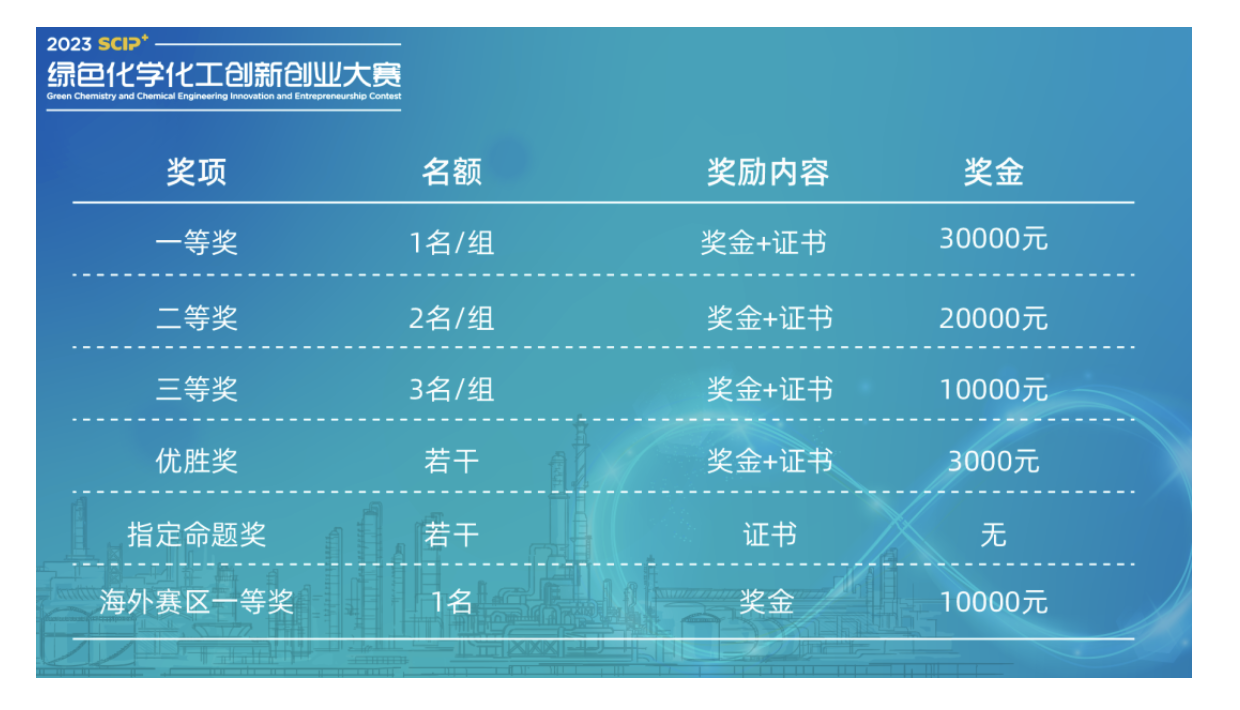
Suez's designated proposition for the 2023 "SCIP+" Green Chemical and Chemical Innovation and Entrepreneurship Competition released
Since its launch in 2019, the "SCIP+" Green Chemical and Chemical Innovation and Entrepreneurship Competition has become one of the most influential innovation and entrepreneurship events in the industry. Entering its fifth year, the "SCIP+" competition will have the theme of "Green and Future", strengthen innovation and leadership around the needs of the chemical industry in the three major areas of "future materials, future energy, and future carbon cycle" to promote green development of the industry.
The competition specially features enterprise-designated proposition units. Participants can provide project solutions or entrepreneurial practice results based on the innovation needs of enterprises. The designated proposition winning team will have the opportunity to in-depth docking with the proposition company to achieve win-win cooperation. The competition organizing committee will also successively release interpretations of propositions from competition partners to help participants better understand the needs of the company and optimize and polish innovative projects.
2023 SCIP Suez Enterprise Designation Proposition
Continuous-flow biological hydrogen production technology based on biomass recycling
Background description:
Hydrogen energy is one of the important clean energy carriers and is receiving more and more attention. Hydrogen production technology based on biomass recycling focuses on the use of sustainable raw materials and is an important alternative to hydrogen production by electrolysis of water and traditional petrochemical raw materials. Among them, biological hydrogen production technology relies on the catalytic activity of enzymes to convert water molecules and organic substrates in biomass into hydrogen at room temperature and pressure. It is suitable for low-solid feed materials such as high-concentration organic wastewater, excess sludge, kitchen waste, Glycosylated cellulose and other raw materials.
However, in the industrialization process, related technologies still widely face problems such as difficulty in selecting microbial species, complex gas production components (difficulty in separation), low conversion efficiency, and poor continuity.
Company concerns:
A team that can provide continuous flow biological hydrogen production technology and has good industrial application potential. The biomass raw materials involved in the technology are not clearly limited. In terms of technology selection, priority is given to dark fermentation technology, while the synergy between biological hydrogen production and other technologies is encouraged (such as hydrogen production/methane production synergy, microbial electrolytic cell MEC, etc.) to increase hydrogen yield.
Chemical energy storage technology for sustainable energy electricity
Background description:
The production of clean energy electricity (such as wind power and solar power) usually has geographical limitations, which in turn brings difficulties in transmission, distribution and use. New energy chemical energy storage technology (internationally known as E-fuel) is a type of technology that uses clean energy generation to convert electrical energy into energy carriers that are easy to store and transport (such as gaseous fuels such as hydrogen or liquid fuels such as methanol). Solve the pain points of power storage.
Company concerns:
Mature technologies that can use green electricity to capture carbon dioxide and electrolyze water, as well as subsequent further synthesis of liquid fuels (such as methanol). There is no clear limit on the source of carbon dioxide captured, and technologies that can capture carbon dioxide tail gas from waste incineration are encouraged.
Physical and chemical recycling technology for waste plastics
Background description:
China is a major country in plastics production and consumption. For a long time, a large amount of plastics that are not easy to recycle have entered waste incineration plants and been burned, converted into carbon dioxide emissions. In recent years, the promotion of classification and recycling of urban domestic waste is greatly promoting the process of plastic resource utilization. As Europe began to put forward clear requirements for the proportion of renewable plastics in imported plastic products, more and more production companies began to generate demand for recycled plastics. With the opening up of policies, the recycling of high-quality plastics such as "bottle to bottle" and their direct use in the production of food-grade plastic packaging has created huge market potential.
The main difference between "solid waste" and "resources" is that the former is a mixture of complex components, so it is necessary to strengthen the separation of target substances when carrying out resource recycling. How to balance the relationship between "separation of energy-consuming inputs" and "value output of recycled materials" has become an important concern when evaluating a technology.
Company concerns:
High-quality recycling technology for food-grade PET plastics, and a company or team that can quickly achieve large-scale industrial production. There will be no restrictions on the type of recycling technology (physical/chemical recycling), but the costs for separation and granulation will be carefully accounted for.
Biochar preparation and downstream application development
Background description:
Biochar is a solid product obtained by thermal cracking of biomass under anoxic conditions. Its application in agriculture, environment, and low-carbon cycles has attracted widespread attention. Under different raw materials and preparation process conditions, the properties of biochar (such as specific surface area, functional group composition, water holding capacity, etc.) vary greatly, which in turn affects its downstream application scenarios. At the same time, the connection between downstream utilization of biochar and carbon credit certification has also aroused great interest in the industry.
Company concerns:
A biochar preparation process suitable for large-scale production. We encourage preparation processes to focus on obtaining products with higher adsorption properties. At the same time, focus on companies or teams that can obtain voluntary carbon emission reduction certification through biochar preparation and utilization.
High-temperature thermal cracking and gasification technology for producing syngas
Background description:
The resource utilization of low-quality biomass or carbon-containing solid waste (such as domestic waste such as low-quality plastics) is an important path to "turn waste into energy" and realize the replacement of petrochemical raw materials. Among them,"syngas" obtained through high-temperature thermal cracking and gasification technology is used as chemical raw materials, which may become an important alternative to waste incineration for power generation in the future. However, synthesis gas produced from low-quality materials usually has complex components and requires more complicated separation processes to enter the downstream utilization stage, so technological innovation is urgently needed.
Company concerns:
Thermal cracking and gasification processes to produce synthesis gas using domestic waste and low-quality biomass as raw materials, and subsequent gas purification processes. We encourage teams in this field to consider maximizing the use of existing waste incineration facilities for renovation, supplemented by gas purification equipment, to produce high-quality syngas.
2023 SCIP Enterprise Introduction--SUEZ
Faced with increasingly severe environmental challenges, Suez Group has been committed to providing basic services to protect and improve people's livelihood for more than 160 years, and with its innovative and resilient solutions, it provides customers with water and solid waste services. The group's 40,000 employees in 40 countries actively empower customers, create value and promote low-carbon transformation throughout the entire life cycle of assets and services. In 2022, Suez Group will produce drinking water for 68 million people around the world and provide sanitation services to more than 37 million people. It will produce 3.7 TWh of energy through sewage and solid waste treatment and avoid 4 million tons of carbon dioxide emissions. Suez Group's revenue in 2022 will be 8.8 billion euros*。
Suez entered the Asian market about 70 years ago, starting in Southeast Asia and then expanding to China for nearly 50 years. Suez employs more than 6500 people in Asia and has built more than 600 water and sewage treatment plants. The Group works with partners across the country to provide water and solid waste resource management services to more than 25 million people and 19 industrial parks. In China, Suez is recognized as one of the most influential companies and a benchmark for leading the Asian environmental protection industry. Today, Suez has cooperation projects with municipal and industrial customers across the country in more than 30 major cities and regions in China. It operates the first PPP project in China's water industry in Macau, operates one of Asia's largest hazardous waste incineration facilities in Shanghai, and invests more than RMB 4 billion in Chongqing.
*Accounting is carried out on a 12-month basis.
Participants and requirements
The competition sets up an entrepreneurial innovation group and an entrepreneurial practice group:
Entrepreneurial Innovation Group Participants Undergraduate and postgraduate students in institutions of higher learning and scientific research institutes, undergraduate and postgraduate graduates in full-time non-adult education, young university teachers, and young enterprise scientific and technological workers.
Applicant Must be the project leader
The participants have the theme of "Green·Shaping the Future", have innovative scientific research results, form innovative product upgrade suggestions or market development suggestions, and have complete project proposals that can transform results.
Entrepreneurial Practice Group Participants Domestic and foreign start-ups and teams of registered companies should have basic product, technology or service prototypes, have their own intellectual property rights, and seek commercial scale.
ApplicantMust be the founder, legal representative or technical leader of the company and team.
to the schedule
Launch and registration| June 27-September 30
Each participating team will register and submit entries through the competition website ( plus.scip.com.cn).
Primary and semi-finals| October-November
In October, the judging committee selected the teams to enter the semi-finals in accordance with the judging rules, and the organizing committee notified the semi-finals teams by email, phone, etc.
In November, the organizing committee organized an online rematch and selected the finalists. The organizing committee notified the finalists through email, phone, etc.
Shortlisted team optimizes works| before the final
The organizing committee will hire industry experts to provide pre-competition guidance to the finalists in order to obtain better display results and stronger competitiveness.
finals| 12 months
The teams participating in the finals held on-site displays and reviewed by a review team composed of experts from industry, capital and other industries.
accelerated incubation| after the final
Conduct a week-long immersive incubation training for the award-winning team to provide support in innovative thinking, customer verification, and product/service design, establish a sustainable and large-scale business model, conduct influence testing, project roadshows and investor matchmaking meetings.
competition award

In addition to bonuses, award-winning projects will also have opportunities to:
-
Obtained funding from the Angel Fund."Young Eagle Project".
-
Conduct immersive business inspections and accelerated incubation and docking with investors.
-
Communicate with industry experts to carry out industrial docking application implementation and market development.
-
Get free workstations at the Shanghai International Chemical New Materials Innovation Center in the Shanghai Chemical Industry Zone, and enjoy corresponding support policies for R & D, pilot, and other activities (refer to the "Implementation Measures for Special Support for Promoting High-Quality Industrial Development in Shanghai Chemical Industry Zone").
participation method
Each team can enter the contest website http://plus.scip.com.cn from the computer to register and submit their entries
for enquiries
Welcome to add IH Fellow WeChat (Note: SCIP)
